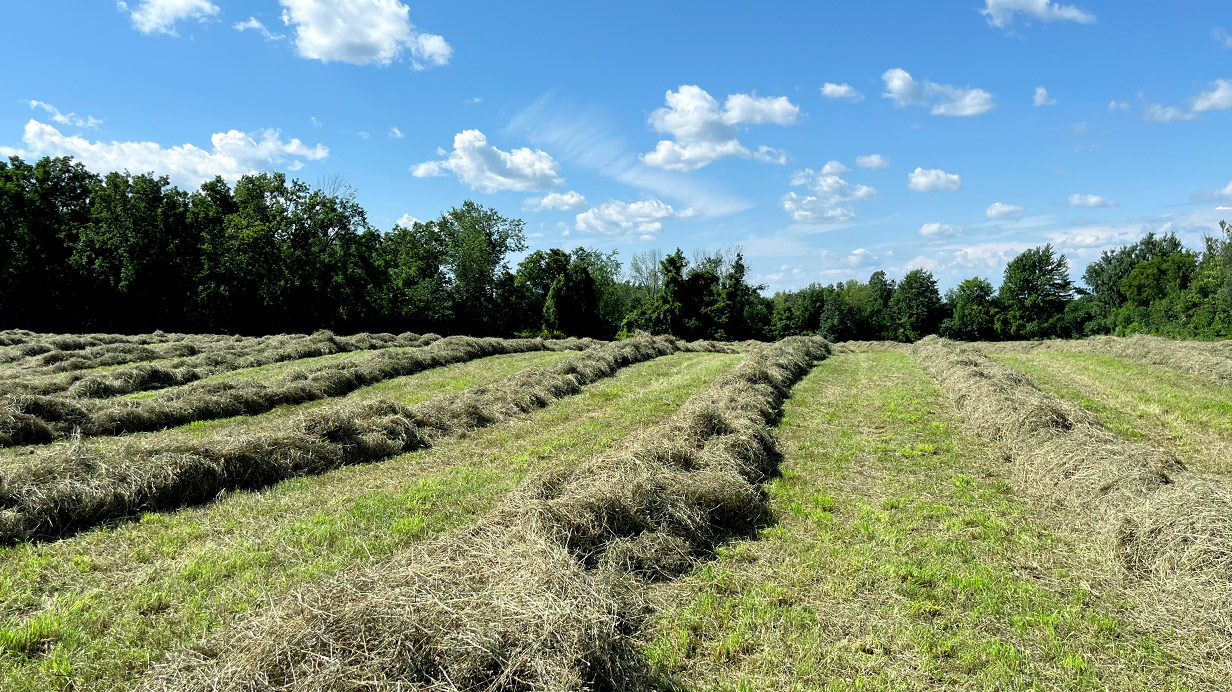Heavy rains: Adressing issues with hay quality for your horses
Heavy and frequent rains come with a fair share of problems for hay farmers and horse owners. With harvests delayed week after week and limited drying time, forage can become less nutritious and less healthful. Below, you’ll find some tips and possible solutions for dealing with this issue.
How to identify wet hay
Hay is considered insufficiently dry when its moisture content is over 14% (<86% dry matter). As a result, mould and dust accumulate on the hay, leading to respiratory problems in horses who are exposed for prolonged periods. The presence of mycotoxins in wet hay can also cause serious health problems.
Moisture content can be determined with an electronic tester, laboratory analysis, or a visual examination. There are several signs that can indicate that hay is wet, including:
a dusty or mouldy odour;
a greyish, whitish or blackened colour;
the presence of dust when hay is handled;
heat at the centre of the hay bail.*
*Warning: Hay that is too wet can overheat and spontaneously combust (catch fire).
The consequences of late harvests
Be aware that nutritional values are affected when you delay harvesting week after week as you wait for better weather. A late hay harvest will:
reduce protein levels;
reduce digestibility and calories;reduce p
latability and voluntary intake (leading to waste);
reduce mineral levels.
How can you limit these effects?
Adjust your horses’ daily ration
You can do one or many of the following:
Mix mature hay with second-cut hay or alfalfa hay. Make sure that the different cuts of hay are accessible in the hayloft or barn all year round;
Replace part of the hay with a substitute high in digestible fibre, such as EconoFoin. Use one kilogram for each kilogram of hay you are substituting. Serve wet;
Give your horses a vitamin and mineral supplement that is appropriate for the hay analysis results. Adjust the quantity given. For example, Tonix contains a higher level of fibre and digestible protein than EquiBalance. However, it must be given in larger doses;
Add Topp40 protein supplement to a horse’s daily ration if the animal has a good body condition, but the protein content is insufficient to meet its needs and maintain its muscle mass;
Add a complete feed to the daily ration or increase the quantity given if the horse is unable to maintain a body condition score of between 5 and 6 out of 9 on an all-hay diet.
Warning!
To prevent respiratory problems, it is crucial that horses are not fed dusty hay. However, for short periods, if the only forage available contains a small quantity of dust, it is possible to limit negative impacts by:
soaking the hay in fresh water for 10 to 30 minutes before serving;
replacing part of the hay with a hay substitute such as EconoFoin. Use one kilogram of substitute per kilogram of hay. If all the hay must be replaced, opt for a 50:50 mixture of EconoFoin and large cubes of alfalfa or timothy/alfalfa.
For horses with chronic respiratory problems, a hay steamer may be an option to consider. But be cautious with homemade steamers. If the temperature at the centre of the bale does not reach 90 °C for at least 10 minutes, the process may cause pathogenic bacteria to multiply instead of controlling germs and respirable particles.¹
Note that hay nets are best avoided when hay is dusty. They will increase the amount of respirable suspended particulates and endotoxins in the horse’s breathing zone.
Opt for wrapped hay bales
When the weather doesn’t allow for a sufficiently dry hay harvest, certain farmers choose plastic-wrapped hay bales. This method allows hay to be harvested at a moisture content as low as 50%. Conservation is ensured thanks to anaerobic fermentation, which reduces the pH of the hay.
For horses, it is more common to find “semi-dry” wrapped hay bales on the market, which have approximately 70% dry matter. Several precautions must be taken when this forage type is chosen, as the risk of botulism is increased and can cause serious consequences, including death.
Horses should be vaccinated to prevent botulism (discuss with your veterinarian).
Be very careful to keep the plastic intact when handling wrapped bales. Avoid letting air into the bales at all costs, as it will cause secondary fermentation and deterioration of the hay.
Horses should consume the open bales within two to three days at most (summer and winter). Make sure that your herd is large enough to eat all the hay in time.
Add a preservative
Hay treated with propionic acid, such as Solution Foin, is also available on the market. This preservative is applied when the hay is baled, when the moisture content is around 20%. It creates an environment that inhibits yeast and mould formation. Propionic acid is safe for horses. However, they can detect the distinctive odour of treated bales. Intake may be reduced in the beginning, but most horses gradually get used to the smell.
References:
Meriel J.S. Moore-Colyer, Jessica, L.E. Taylor, Rebecca James. (2016). The Effect of Steaming and Soaking on the Respirable Particle, Bacteria, Mould, and Nutrient Content in Hay for Horses. Journal of Equine Veterinary Science, Volume 39, 62–68.
Dany Cinq-Mars, Agr. Ph.D. (May 3, 2004). L’alimentation du cheval pour éviter ou contrôler les problèmes respiratoires. Division nutrition et alimentation, MAPAQ, Direction de l’innovation scientifique et technologique.
Krishona Martinson, University of Minnesota; Dan Undersander, University of Wisconsin. (December 2015) What’s the Value of Rained-On Hay as Horse Feed? Forage Focus.
Ivester, K.M., Couëtil, L.L., Moore, G.E., Zimmerman, N.J., Raskin, R.E. (2014). Environmental exposures and airway inflammation in young thoroughbred horses. Journal of Veterinary Internal Medicine, 28(3), 918–924.
Ministry of Agriculture, Food and Rural Affairs of Ontario. (May 24, 2022). Hay, haylage and treated hay for horses. https://www.ontario.ca/page/hay-haylage-and-treated-hay-horses.
Ministry of Agriculture, Food and Rural Affairs of Ontario. Spontaneous Combustion and Hay Fires. https://omafra.gov.on.ca/english/livestock/dairy/facts/hayfires.htm



